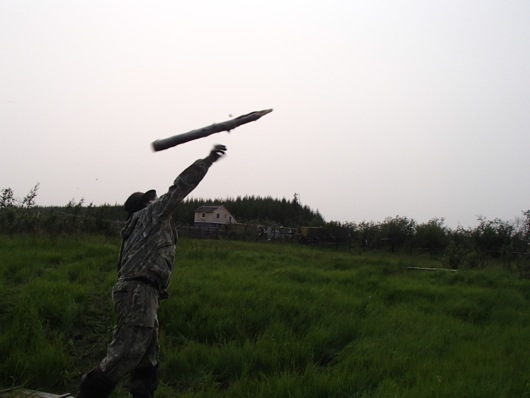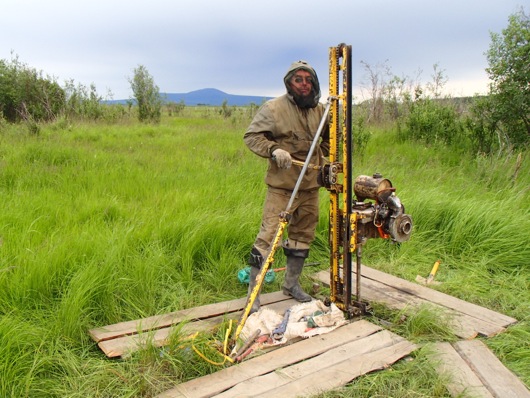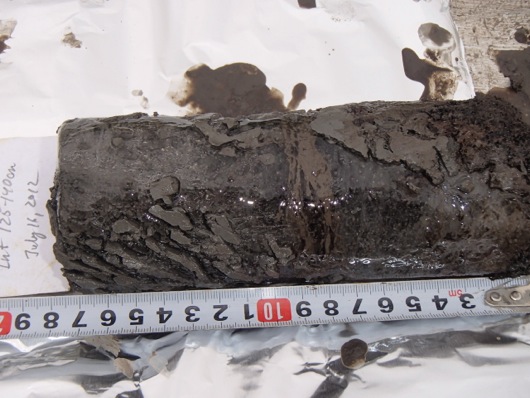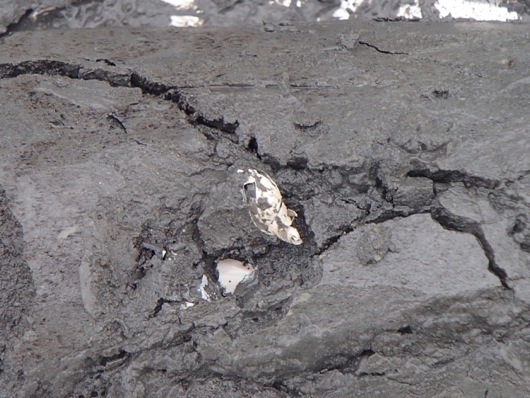(Mark Paricio is a PolarTREC Teacher accompanying the Polaris Project this summer. To read all of Mark’s journals, go to: http://www.polartrec.com/expeditions/siberian-arctic-systems-study )
Two Tales of Drilling in Pleistocene Park
In talking to my new Russian friends on the permafrost drilling team, they corrected me as to my perspective of the science of drilling. Drilling, they said, is not science, it is simply collecting the data. The science begins when the data are analyzed and compared so that a new or better understanding of processes can be found. However, they did agree on the point that the scientists have to be willing to do the drilling and set up the sensors to get the data. The interesting part of fieldwork is that, as we begin to collecting the data, we have also collected some interesting stories.

We found Pleistocene Man! Actually, it’s Dr. Valentine Spektor showing a sense of humor with a home-made table leg while setting up the drilling site.
A Story of Persistence – Mechanical Failure Strikes!
After setting up our drill rig and drilling the better part of a day, our borer became stuck on something at a depth of 3.33 meters more that 20% of our desired depth. Using every trick in the book, Dr. Sasha Kholodov worked for 20 minutes to get the borer and the inch thick iron rods attached to it back out of the hole. This is an exhausting process when it works, but it was extremely difficult this time. Worse, one of the rods broke due to metal fatigue about a meter below ground and we lost one of our three medium-sized borers and two meters of metal rods in the hole blocking the borehole and making it unusable. BAD LUCK!
After a short break, we moved the drill rig and equipment (several hundred pounds in all) and started again. When we reached 3 meters in depth on our second hole, Dr. Valentin Spektor, set down one of our remaining medium-sized borers next to the hole after extracting a core and it broke in a similar fashion – right next to the hole as we about to use it. GOOD LUCK!
Sometimes, when something breaks, it is good luck! Had we shoved the borer into the hole, it surely would broken immediately, blocking our second hole! We would have had to start again! We finished the day drilling down to about 8 meters in depth, using our only remaining medium-sized borer. We still have 7 meters to go, but only the next 2 or 3 need this borer. (Knock on permafrost!) Up here, you simply can’t go out to Walmart and buy a new part for your permafrost borer.

Dr. Sasha Kholodov drills the second borehole at Pleistocene Park.
A Better Story – More to the Core of the Science
Mechanical issues aside, the cores we have taken out of the Pleistocene Park borehole have displayed a wide variety of cross-sections compared to the cores we took out at the science station near Cherskiy, which were largely frozen silt with ice crystals. A couple of our first cores were frozen peat, hard but light with a very low density. Then, the cores transitioned to contain ice lenses as well in some fascinating patterns.

The pattern of silt and ice in one permafrost core. The top (right) of this core is frozen peat.
But the most interesting core of the day, was when we took cores from an area that may have been an old streambed. In this core, we found sediments, small sticks, and numerous shells. One particular shell was a spiral shell, more than a centimeter in length that was well preserved.

This spiral shell (about 1 cm thick) was found in the permafrost core between 7 to 8 meters down.
Although we don’t know the whole story yet, it is fascinating to think that it has been buried there for thousands of years, and is now a clue for scientists to use in their studies!
Stay curious my friends! – Mark Paricio



